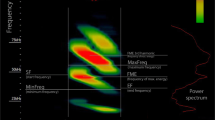Summary
A positive relationship was established between energy expenditure and pulse rate of echolocation for 8 pipistrelle bats (Pipistrellus pipistrellus) when hanging at rest in a respirometry chamber at 28 °C. The least squares fit equation: Energy expenditure (J·−1·h−1)=110.09+ 40.3 pulse rate (n/s) explained 14% of the minute by minute variation in energy expenditure. For a 6 g bat therefore each pulse costs approximately 0.067 Joules to produce. The net cost of echolocation at 10 pulses per second for a 6 g pipistrelle bat was predicted to be 9.5 × BMR with a range of 7.0–12.2 × BMR. We suggest that since a major portion of the cost of echolocation may result from contraction of the pectoralis and scapularis groups of muscles, the cost of echolocation is reduced for flying animals which contract these muscles anyway during flight. This may account for the high incidence of echolocation systems amongst flying vertebrates, when compared with terrestrial species.
Similar content being viewed by others
References
Ahlen I (1987) The identification of Scandanavian bats by their sounds. Swedish Univ Agric Sci, Wildlife Ecol Report 6
Bell GP (1982) Behavioural and ecological aspects of gleaning by a desert insectivorous bat,Antrozous pallidus (Chiroptera: Vespertilionidae). Behav Ecol Sociobiol 10:217–223
Bell GP (1985) The sensory basis of prey location by the Californian leaf-nosed batMacrotus californiens (Chiroptera: Phyllostomidae). Behav Ecol Sociobiol 16:343–347
Carpenter RE (1986) Flight physiology of flying foxes. J Exp Biol 114:619–649
Dawkins R (1986) The blind watchmaker. Longman Sci Techn, Bath, Avon
Fattu JM, Suthers RA (1981) Subglottic pressure and the control of phonation by the echolocating bat,Eptesicus. J Comp Physiol 143:465–475
Fielder J (1979) Prey catching, with and without echolocation in the Indian False Vampire (Megaderma lyra). Behav Ecol Sociobiol 6:155–160
Griffin DR (1946) The mechanism by which bats produce supersonic sounds. Anat Rec 96:519
Griffin DR (1953) Acoustic orientation in the oil bird (Steator nis). Proc Natl Acad Sci USA 39:884–893
Griffin DR (1958) Listening in the dark. Yale University Press, New Haven
Hemmingsen AM (1960) Energy metabolism as related to body size and respiratory surfaces and its evolution. Rep Steno Memorial Hospital Nordink Insulin Laboratorium 9:6–110
Howell DJ (1979) Flock foraging in nectar-feeding bats: advantages to the bats and to the host plants. Am Nat 114:23–49
Jepsen GL (1970) Bat origins and evolution. In: Wimsatt WA (ed) Biology of Bats, vol I. Academic Press, New York, pp 1–62
Kleiber M (1961) The fire of life: an introduction to animal energetics. Wiley, New York
Kolb A (1961) Sinnesleistungen einheimischer Fledermäuse bei der Nahrungssuche und Nahrungsauswahl auf dem Boden und in der Luft. Z Vergl Physiol 44:550–564
Lusk G (1926) The elements of the science of nutrition, 4th edn. Academic Press, New York
Machin KE, Lissmann HW (1960) The mode of operation of the electric receptors inGymnarchus niloticus. J Exp Biol 37:801–811
McNally R, Young D (1981) Song energetics of the bladder cicadaCystosoma saundersii. J Exp Biol 90:185–197
Morse PM (1948) Vibration and sound, 2nd edn. McGraw-Hill, New York
Norris KS, Prescott JH, Asa-Dorian PV, Perkins P (1961) An experimental demonstration of echo-location behaviour in the porpoiseTursiops truncatus (Montagu). Biol Bull 120:163–176
Novick A (1959) Acoustic orientation in the cave swiftlet (Col- localia brevirostris unicolor). Biol Bull 117:487–503
Peters RH (1981) The ecological implications of body size. In: Beck E, Birks HJB, Connor EF (eds) Cambridge studies in ecology. Cambridge University Press, Cambridge, pp 329
Pettigrew JD (1986) Flying primates? Megabats have the advanced pathway from eye to midbrain. Science 231:1304–1306
Prestwich KN, Breuer CK (1987) The design of advertisement calls when energy is a limiting factor. Am Zool 43A: Abstr 206
Racey PA, Speakman JR (1987) The energy costs of pregnancy and lactation in heterothermic bats. In: Loudon ASI, Racey PA (eds) Reproductive energetics in Mammals. Symp Zool Soc Lond 57:107–125
Racey PA, Swift SM (1985) Feeding ecology ofPipislrellus pipistrellus (Schreber) (Chiroptera: Vespertilionidae) during pregnancy and lactation. I. Foraging behaviour. J Anim Ecol 54:205–215
Ryan MJ (1988) Energy, calling and selection. Am Zool 28:885–898
Sales G, Pye D (1974) Ultrasound communication by animals. Chapman and Hall, London
Schnitzler HU (1968) Die Ultraschall-Ortungslaute der Hufeisen-Fledermäuse (Chiroptera-Rhinolophidae) in verschiedenen Orientierungssituationen. Z Vergl Physiol 57:376–408
Simmons JA, Vernon JA (1971) Echolocation: discrimination of targets by the bat,Eptesicus fuscus. J Exp Zool 176:315–328
Speakman JR, Racey PA (1987) The energetics of pregnancy and lactation in the brown long-eared batPlecotus auritus. In: Fenton MB, Racey PA, Rayner JMV (eds) Recent advances in the study of bats. Cambridge University Press, Cambridge, pp 367–395
Suthers RA, Fattu JM (1973) Mechanisms of sound production by echolocating bats. Am Zool 13:1215–1226
Suthers RA, Thomas SP, Suthers BJ (1972) Respiration, wingbeat and ultrasonic pulse emission in an echo-locating bat. J Exp Biol 56:37–48
Swift SM, Racey PA, Avery MI (1985) Feeding ecology ofPipistrellus pipistrellus (Chiroptera: Vespertilionidae) during pregnancy and lactation. II. Diet. J Anim Ecol 54:217–227
Thomas SP (1987) The physiology of bat flight. In: Fenton MB, Racey PA, Rayner JMV (eds) Recent advances in the study of bats. Cambridge University Press, Cambridge, pp 75–100
Author information
Authors and Affiliations
Rights and permissions
About this article
Cite this article
Speakman, J.R., Anderson, M.E. & Racey, P.A. The energy cost of echolocation in pipistrelle bats (Pipistrettus pipistrellus). J. Comp. Physiol. 165, 679–685 (1989). https://doi.org/10.1007/BF00610999
Accepted:
Issue Date:
DOI: https://doi.org/10.1007/BF00610999




